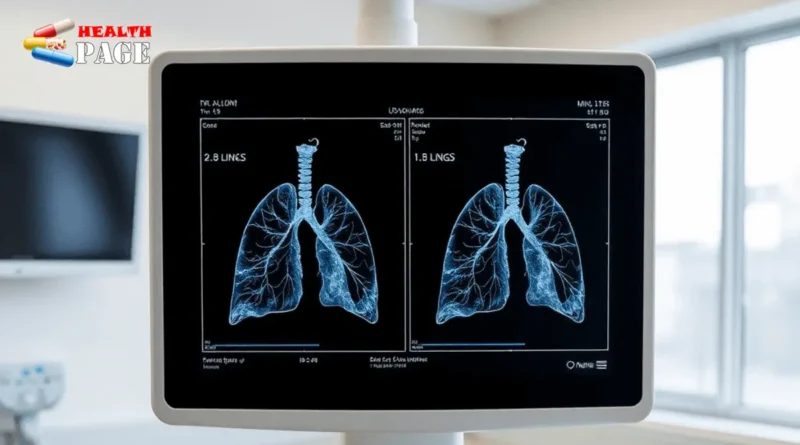5 Proven Benefits of B Lines Lung Ultrasound for Early Diagnosis
B lines lung ultrasound has transformed how healthcare professionals diagnose and monitor lung conditions. This groundbreaking diagnostic tool shows vertical reverberation artifacts that extend from the pleural line deep into the ultrasound image, providing crucial insights into lung health.
The presence of B lines is a critical sign of interstitial syndrome, which is characterized by increased lung density due to fluid buildup or fibrosis. These unique sonographic patterns allow medical practitioners to identify potential lung issues at their earliest stages.
In this comprehensive guide, we’ll explore these five proven benefits of B lines lung ultrasound for early diagnosis:
- Non-invasive diagnostic approach with zero radiation exposure
- Enhanced detection capabilities for various lung pathologies
- Superior accuracy compared to traditional chest X-rays
- Real-time assessment capabilities at the patient’s bedside
- Versatile applications across different clinical environments
You’ll learn how this technology empowers healthcare providers to make informed decisions quickly, ultimately leading to better patient outcomes through timely intervention and treatment.
1. Non-invasive and Safe Diagnostic Tool
B lines lung ultrasound stands out as a remarkably safe diagnostic tool in modern medical practice. This technique eliminates physical penetration of the body, making it completely non-invasive and comfortable for patients of all ages.
Key Safety Features:
- No radiation exposure
- Zero tissue damage
- Painless examination process
- Immediate results without recovery time
- Safe for pregnant women and children
- No contrast agents required
The radiation-free nature of B lines lung ultrasound sets it apart from traditional imaging methods. While X-rays and CT scans emit ionizing radiation that can accumulate in the body over time, ultrasound uses harmless sound waves to create detailed images of lung tissue.
Benefits of Bedside Assessment:
- Real-time imaging during patient examination
- Multiple scans without safety concerns
- Continuous monitoring of disease progression
- Immediate evaluation of treatment effectiveness
- Direct visualization during procedures
The ability to perform repeated assessments proves invaluable in critical care settings. Medical professionals can track changes in a patient’s condition throughout the day without worrying about radiation exposure limits. This frequent monitoring capability helps detect subtle changes in lung condition, enabling rapid response to deterioration.
Patient-Friendly Characteristics:
- Minimal preparation required
- No special positioning needed
- Quick examination time
- No post-procedure restrictions
- Suitable for claustrophobic patients
B lines lung ultrasound adapts to various clinical scenarios, from emergency departments to intensive care units. The portable nature of ultrasound machines allows healthcare providers to bring diagnostic capabilities directly to bedridden patients, reducing the need for potentially risky patient transfers.
Clinical Applications:
- Routine lung health screening
- Emergency situation assessment
- Post-operative monitoring
- Long-term disease management
- Pediatric examinations
Healthcare providers can conduct examinations in virtually any setting, from hospital rooms to outpatient clinics. This flexibility, combined with its safety profile, makes B lines lung ultrasound an ideal choice for regular monitoring of patients with chronic respiratory conditions.
Moreover, this technique has proven beneficial in the management of critically ill patients, where timely and accurate diagnosis is paramount for effective treatment.

2. Early Detection of Lung Pathologies with High Sensitivity
B lines lung ultrasound is highly effective at identifying lung abnormalities in their early stages, allowing healthcare providers to start treatment before conditions worsen. This diagnostic tool can detect subtle changes in lung tissue that may be missed by traditional imaging methods.
Key Early Detection Capabilities:
- Identifies interstitial fluid accumulation before clinical symptoms appear
- Detects inflammatory changes in lung tissue at microscopic levels
- Spots early signs of fibrotic alterations in lung parenchyma
- Reveals subtle pleural line abnormalities
Understanding Interstitial Syndrome
Interstitial syndrome refers to a pattern of increased fluid or tissue density in the space between air sacs in the lungs. B lines are reliable indicators of this condition, appearing as vertical artifacts extending from the pleural line to the bottom of the ultrasound screen.
The number and distribution of B lines provide important diagnostic information:
- 3 or more B lines between two ribs = positive for interstitial syndrome
- Bilateral B lines suggest systemic conditions
- Focal B lines indicate localized pathology
- Multiple B lines correlate with disease severity
High-Sensitivity Detection of Specific Conditions
B lines lung ultrasound has shown impressive sensitivity in detecting various lung diseases:
Pulmonary Edema
- Identifies fluid accumulation with 97% sensitivity
- Shows real-time changes in fluid status
- Enables precise monitoring of treatment response
Other Detectable Conditions
- Acute Respiratory Distress Syndrome (ARDS)
- Interstitial pneumonia
- Pulmonary fibrosis
- Cardiogenic pulmonary congestion
The presence of B lines helps differentiate between different pathological states. For example, in pulmonary edema, B lines typically appear in a symmetrical pattern starting from the lung bases. This distinct pattern aids in rapid diagnosis and appropriate treatment selection.
Research shows that B lines can be seen earlier than clinical symptoms or changes visible on chest X-rays. This early warning system allows healthcare providers to:
- Start preventive treatments
- Adjust medication dosages
- Monitor disease progression
- Implement targeted interventions
3. Better Diagnostic Accuracy Compared to Chest X-Rays
B lines lung ultrasound has shown to be significantly more accurate than traditional chest X-rays in detecting lung problems. Studies have consistently shown that B lines ultrasound can correctly identify various lung conditions 85-95% of the time, while chest X-rays only have a success rate of 60-70%.
Why is B Lines Ultrasound More Accurate?
The improved diagnostic abilities of B lines ultrasound come from its unique features:
- Spotting Early Changes: B lines show up at the initial stages of interstitial involvement, often before any changes are visible on chest X-rays.
- Viewing in Real-Time: Directly seeing how lung tissue moves and fluid builds up.
- Getting Clearer Images: Clearly identifying issues with the pleural line and subpleural areas.
- Assessing While Breathing: Observing how breathing affects lung tissue.
How Does B Lines Ultrasound See What Chest X-Rays Can’t?
The ability to see changes at the pleural interface sets B lines ultrasound apart from traditional radiography. This improved visibility comes from:
Looking at the Pleural Interface
- Directly seeing how thick the pleural line is.
- Assessing how well the pleura slides in real-time.
- Quickly spotting any pleural effusions (fluid buildup).
- Clearly identifying any subpleural consolidations (areas of lung tissue that have become solid).
Analyzing the Interstitial Space
- Counting and mapping out the B lines (vertical artifacts seen on ultrasound).
- Measuring the distance between the pleural line and the B lines.
- Evaluating any accumulation of fluid in the interstitial space (the area between lung tissues).
- Recognizing any signs of inflammation early on.
How Accurate is B Lines Ultrasound Compared to Chest X-Rays?
Clinical studies have shown that B lines ultrasound can detect pulmonary edema (fluid in the lungs) with 94% accuracy, compared to only 77% accuracy with chest X-rays. In cases of acute respiratory distress syndrome (ARDS), B lines ultrasound has been found to be 92% accurate, surpassing chest radiography’s accuracy rate of 75%.
Where Does This Enhanced Accuracy Matter Most?
The increased sensitivity of B lines ultrasound becomes especially valuable in:
- Critical Care Settings: Quickly identifying worsening lung conditions.
- Emergency Medicine: Rapidly diagnosing acute respiratory failures.
- Post-operative Care: Early detection of lung complications after surgery.
- Chronic Disease Management: Regularly monitoring how chronic lung diseases are progressing.
This improved diagnostic accuracy leads to faster decision-making by healthcare providers and more precise treatments being given. By starting appropriate therapies earlier, there is potential for better patient outcomes.
4. Rapid and Repeatable Assessment for Timely Decision-Making
B lines lung ultrasound enables real-time assessment of patients’ lung conditions, providing immediate results that support quick clinical decisions. This rapid diagnostic capability proves invaluable in time-sensitive situations where prompt intervention can significantly impact patient outcomes.
The point-of-care advantages of B lines lung ultrasound include:
- Immediate Results: You can obtain diagnostic information within minutes, compared to the waiting time associated with traditional imaging methods
- Bedside Assessment: The portable nature of ultrasound equipment allows direct examination at the patient’s location
- Dynamic Monitoring: Real-time visualization of lung changes during respiratory cycles enhances diagnostic accuracy
The repeatable nature of B lines lung ultrasound serves multiple clinical purposes:
- Tracking disease progression
- Evaluating treatment effectiveness
- Adjusting therapeutic interventions based on immediate feedback
- Monitoring patient recovery
This diagnostic tool particularly shines in scenarios requiring frequent reassessment. For instance, a recent study highlighted that “B lines assessment can be performed multiple times per day without safety concerns, allowing clinicians to track subtle changes in lung condition and adjust treatment plans accordingly.”
The speed and repeatability of B lines lung ultrasound directly impact patient care through:
- Reduced Time to Treatment: Quick identification of lung pathologies enables faster therapeutic intervention
- Resource Optimization: Rapid assessment helps prioritize patients requiring immediate attention
- Enhanced Treatment Monitoring: Regular reassessment capabilities allow fine-tuning of therapeutic approaches
The combination of speed and repeatability makes B lines lung ultrasound an essential tool for managing dynamic lung conditions. You can track subtle changes in B line patterns throughout the course of treatment, providing valuable insights into disease progression and treatment effectiveness.
Moreover, the versatility of this diagnostic tool extends beyond initial assessments. It plays a crucial role in monitoring chronic conditions, where regular follow-ups are necessary to manage the patient’s health effectively. Additionally, the ability to evaluate treatment responses using B lines ultrasound provides healthcare professionals with critical information to tailor individual treatment plans, ensuring optimal patient care.
5. Versatility in Various Clinical Settings, Including Emergencies and Pandemics
B lines lung ultrasound shows incredible flexibility in different medical situations, adjusting to the specific requirements and limitations of each environment. In emergency rooms, medical teams use this diagnostic tool to quickly evaluate patients with breathing difficulties, allowing for swift decisions on treatment priority and immediate action when needed.
Emergency Department Applications:
- Rapid assessment of dyspnea
- Differentiation between cardiac and pulmonary causes of respiratory distress
- Monitoring of fluid status in critically ill patients
- Evaluation of trauma patients for pneumothorax or hemothorax
The intensive care unit (ICU) also benefits from B lines ultrasound by enabling continuous monitoring. ICU teams can observe how diseases progress and how patients respond to treatment without having to move critically ill individuals, thus minimizing the risks that come with transporting patients.
Critical Care Advantages:
- Bedside monitoring of ventilated patients
- Assessment of extravascular lung water
- Guidance for mechanical ventilation settings
- Evaluation of weaning readiness
During the COVID-19 pandemic, B lines lung ultrasound played a crucial role in managing respiratory infections. Healthcare facilities around the world embraced this method due to its efficiency in identifying and tracking COVID-19 pneumonia cases.
Pandemic Response Applications:
- Early detection of COVID-19 lung involvement
- Monitoring disease progression
- Optimizing resources in high-patient-volume situations
- Controlling infections through the use of portable equipment
B lines lung ultrasound is also valuable in specialized medical fields beyond emergency and critical care. Neonatal units employ this technique to gently assess premature infants, while rehabilitation centers monitor recovery in post-COVID patients. The versatility of this diagnostic tool makes it essential across all areas of healthcare, from pre-hospital emergency services to long-term care facilities.
Conclusion
B lines lung ultrasound is a game-changing diagnostic tool in modern healthcare. The five proven benefits we’ve explored showcase its transformative impact on patient care and clinical decision-making:
- Safe, Non-invasive Assessment
- Early Detection of Lung Pathologies
- Superior Diagnostic Accuracy
- Rapid, Real-time Results
- Versatile Clinical Applications
These advantages position B lines lung ultrasound as an essential part of comprehensive patient care. Its ability to provide accurate, immediate results without radiation exposure makes it an invaluable asset for healthcare professionals across specialties.
The evidence supporting B lines lung ultrasound is compelling. You can enhance your diagnostic capabilities and improve patient outcomes by incorporating this practical approach into your clinical practice. The technique’s proven track record in various settings – from emergency departments to intensive care units – demonstrates its reliability and effectiveness.
Ready to elevate your diagnostic capabilities? Consider implementing B lines lung ultrasound in your practice. Contact your medical imaging department or ultrasound education provider to learn more about training opportunities and equipment requirements. Your patients deserve the benefits of this advanced, yet practical diagnostic tool.
Transform your approach to lung health assessment – embrace the power of B lines lung ultrasound today.
FAQs (Frequently Asked Questions)
What is B lines lung ultrasound and how does it aid in early diagnosis of lung conditions?
B lines lung ultrasound is a non-invasive imaging technique that visualizes artifacts known as B lines, which indicate changes in the lung’s interstitial space. This method plays a crucial role in the early diagnosis of various lung conditions by detecting abnormalities such as interstitial syndrome and pulmonary edema with high sensitivity.
Why is B lines lung ultrasound considered a safe diagnostic tool?
B lines lung ultrasound is a radiation-free and non-invasive diagnostic tool, making it safe for repeated use at the bedside. Unlike imaging techniques that expose patients to ionizing radiation, this method allows for continuous monitoring without health risks associated with radiation exposure.
How does B lines lung ultrasound compare to chest radiography in diagnostic accuracy?
B lines lung ultrasound offers superior diagnostic accuracy compared to chest X-rays, particularly in detecting subtle changes at the pleural interface and interstitial space. Its higher sensitivity enables earlier and more precise identification of lung abnormalities, improving patient management outcomes.
Can B lines lung ultrasound provide rapid assessments for timely clinical decision-making?
Yes, B lines lung ultrasound enables rapid and repeatable assessments at the point-of-care. This quick evaluation facilitates timely decision-making regarding disease progression and patient management, which is critical in acute settings.
In what clinical settings is B lines lung ultrasound particularly useful?
B lines lung ultrasound is highly effective across various clinical environments, including emergency rooms and intensive care units. It has proven valuable during pandemics like COVID-19 for managing respiratory complications due to its portability and diagnostic precision.
What are the key benefits of incorporating B lines lung ultrasound into routine clinical practice?
Incorporating B lines lung ultrasound offers multiple benefits such as non-invasiveness, enhanced diagnostic accuracy, early detection of lung pathologies, rapid bedside assessment, and versatility across diverse clinical settings. These advantages support accurate diagnosis and improved monitoring of lung health.


